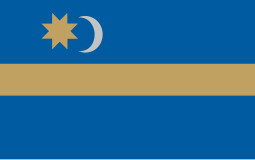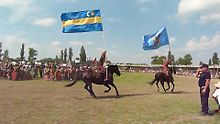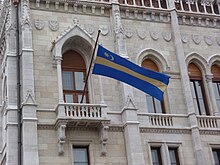Flag of the Székelys
 | |
| Use | Civil |
|---|---|
| Proportion | 2:3 |
| Adopted | 17 January 2004 |
| Design | Azure rectangular flag with a golden horizontal band on its middle and a golden "sun-star" and a silver crescent moon at its upper left corner |
| Designed by | Ádám Kónya |
The flag of the Székelys (Hungarian: Székely zászló; Romanian: Drapelul secuilor) is the flag used by the ethnic Hungarian Székely community of Romania. It is a blue flag with a golden strip and a "sun-star" and crescent moon, both perceived as ancient Székely symbols. Being designed by Ádám Kónya, the Szekler National Council adopted it in 2004 and is since then a symbol for the Székely people. The Romanian authorities have imposed some restrictions on under which conditions may the flag be displayed, which has allegedly fostered its popularity.
It is argued that both the symbols of the flag and its colors are traditional symbols of the Székelys. Regarding the latter, there is no fixed evidence, but the crescent moon and sun have been used since at least the 15th century in Transylvania. However, the use of a "sun-star" as Kónya has defined it is controversial as it does not comply with heraldic rules. Apart from the blue and golden one, there is another unofficial version of the Székely flag, a red and black one used by some Székely groups and organizations.
Design
[edit]
The flag of the Székelys was designed by Ádám Kónya and officially adopted in 2004. It is a blue rectangular flag with a ratio of 2:3. The azure (blue) background is cut by a horizontal golden bar in a 2:1:2 ratio. On the side of the flagpole within the upper blue bar is an eight-pointed golden star and a silver crescent moon.[1]
According to Kónya's original description of the flag, the eight-pointed "sun-star" symbolizes the eight historical Székely seats (Bardóc-Miklósvárszék, Csíkszék, Gyergyószék, Kézdiszék, Marosszék, Orbaiszék, Sepsiszék and Udvarhelyszék). The crescent moon and the sun were already considered Székely symbols as early as in the 16th century. In fact, in 1580, they appeared as components of the coat of arms of the Principality of Transylvania and the Transylvanian Diet adopted them as official Székely symbols in 1659. Subsequently, the crescent moon and the sun started to appear on flags and coats of arms of the Székely seats.[2]
It has been claimed that the colors of the flag, blue and golden, were used in military flags of the Prince of Transylvania Moses Székely and that the blue and golden colors used in the coat of arms of the Maros-Torda County are proof of the colors' antiquity as Székely symbols, but this is not confirmed. Also, Moses Székely's flag was not blue and golden, but blue and white.[3]
Experts have also criticized that the sun represented in the Székely flag does not comply with heraldic rules, not being a heraldic sun but in fact not even a star either, but rather a reminiscence of the Székely woven fabric patterns.[3][4]
Red-black version
[edit]
There also is another unofficial version of the Székely flag known by some people as the "old" or "battle flag" of the Székelys. In reality, this version has no historical precedent, as it was created in the second half of the 20th century in the area of Csíkszék using the basic colors of the typical Székely female folk costume as a "revolt" against the Romanian authorities. Today, it is mainly used by the people of Csíkszék, with some mistakenly considering it an old, traditional Székely flag.[5][6]
The black-and-red version is used by the Székely's World Alliance, registered in the United States;[7] and it is also preferred by motorcyclists and rockers.[8]
History
[edit]First Székely symbols and military flags
[edit]
One of the oldest Székely symbols is a 15th-century coat of arms consisting on an armored arm holding a sword on a red background; the sword pierces a golden crown, a heart and the head of a bear, with on either side of the latter being a rising moon and a six-pointed star. The other Székely military flags of the time probably also carried these colors and symbols as well.[2]
Possibly,[2] today's official flag can be traced back to the times of the Transylvanian prince Moses Székely. His military flags led the Székely soldiers in the Battle of Guruslău on 3 August 1601, but after their defeat, the flags were captured and sent to the then Habsburg-ruled city of Prague. The Transylvanian flags that were captured were published in a study from 1893 by Sándor Mika named Erdélyi hadizászlók 1601-ből ("Transylvanian war flags from 1601").[5]
Before the 21st century, there was not any uniform flag for the Székelys. Until 1876, each Székely seat used its own symbols as an independent political unit, and then up to the Treaty of Trianon, the Hungarian state symbols.[2] In modern times, the ethnic Hungarians of Romania started using the Hungarian flag, placing it on buildings. However, a Romanian law passed in 1994 and supplemented in 2001 prohibited the display of the flag of "foreign states", including Hungary, on unofficial occasions, making it impossible to use the Hungarian flag.[9]
Modern flag
[edit]
In 2003, the Szekler National Council was established. It adopted the blue and golden Székely flag and coat of arms by Ádám Kónya, based on old Székely emblems, as its own symbols.[2][5]
As this council is the main advocate of the Székely autonomy movement, these symbols soon became expressions of Székely cohesion, cooperation and self-identity. While the popularity of the flag started gradually increasing, the press and people began to refer to it as the "Székely flag". On 5 September 2009, a Székely organization declared the symbols as the flag and coat of arms of Székely Land.[5] It has been claimed that the Romanians can not relate the Székely claims for autonomy with Hungarian irredentist ideas through the use of the Székely flag since not even a single Hungarian state symbol is on it.[10]
On the following years, the Székely flag would start to appear on several public buildings and also on Székely populated places such as Ciumani (Gyergyócsomafalva) in 2005, in Sfântu Gheorghe (Sepsiszentgyörgy) in 2009, and other ones posteriorly.[11] The Romanian authorities responded to this with numerous final judgments issued since 2013, according to which the Székely symbols must be removed from all public buildings and spaces, including in their interior.[12][13][14] To strengthen this, a new law was adopted in 2015, which further restricted the use of Székely flags.[13]
According to some, the popularity and significance of the Székely flag can be attributed to a certain extent to the persecution and campaign against it of the Romanian authorities.[4][6] According to the Hungarian journalist Levente Balogh, "if they did not start a campaign against it, not many people apart from its inventor would be interested on it. In this way, however, it has also been burned into the minds of those who have little to do with the Székelys anyway, and today it is seen everywhere as a minority symbol persecuted by chauvinist authorities".[15]
It is also used in some places of Hungary. In fact, it started to be hoisted on the Hungarian Parliament Building in Budapest on 15 February 2013, as well as on several municipal buildings in the country.[16]
See also
[edit]References
[edit]- ^ "Határozat a Romániában élő magyar közösség nemzeti szimbólumairól (RMDSZ kongresszus)". Erdély.ma (in Hungarian). 23 February 2019.
- ^ a b c d e Kertész, Melinda (22 February 2013). "Mi is az a székely zászló?". Transindex (in Hungarian).
- ^ a b "Székely jelképek? - I. rész". Krónika (in Hungarian). 2 April 2010.
- ^ a b Makkay, József (25 August 2017). "A székely zászlóról szakértői szemmel". Erdélyi Napló (in Hungarian).
- ^ a b c d Izsák, Balázs (30 April 2010). "A székely jelképekről hitelesen – Kónya Ádám emlékére". Krónika (in Hungarian).
- ^ a b Farkas, Imola (19 October 2010). "A piros–fekete új divat". Székely Hírmondó (in Hungarian).
- ^ "Nyitóoldal" (in Hungarian). Székely's World Alliance. Archived from the original on 22 September 2020. Retrieved 14 November 2020.
- ^ Bálint, Kinga Katalin (5 March 2014). "Székely kokárdát is kitűzhetünk". Székelyhon.ro (in Hungarian).
- ^ Vass, Enikő (12 December 2001). "Tiltott Romániában az idegen zászló és himnusz". Index (in Hungarian).
- ^ Makkay, József (4 February 2019). "A székely nem revíziót, "csak" autonómiát akar – az SZNT folytatná a Székelyföldhöz csatlakozást kimondó határozatok elfogadását". Krónika (in Hungarian).
- ^ Wodianer-Nemessuri, Zoltán (13 June 2016). "Történelmünk a vádlottak padján". Magyar Idők (in Hungarian).
- ^ Bíró, Blanka (22 September 2013). "Folytatódnak a zászlóperek Háromszéken". Krónika (in Hungarian).
- ^ a b Kádár, Hanga; Csaba, Nánó (18 February 2017). "Az üldözött székely zászló". Erdélyi Napló (in Hungarian).
- ^ Pálinkás, István (25 February 2019). "Egy zászló eltávolítása több ezer kitűzött zászló lobogását eredményezi". DUOL (in Hungarian).
- ^ Balogh, Levente (13 December 2015). "Székely bicska a román trikolóron". Főtér (in Hungarian).
- ^ "Kitűzték a székely zászlót a Parlamentre". Origo (in Hungarian). 15 February 2013.
